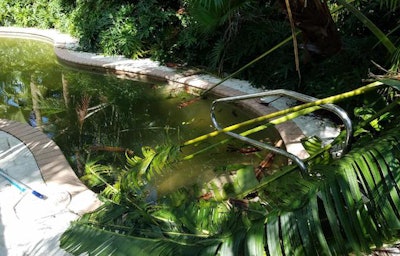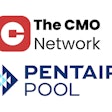
Massive and highly destructive hurricanes have dominated the news recently, and while our first concern after the storm should always be the safety of our families and neighbors, at some point we will need to deal with our pools. When that time comes, here's what to keep in mind:
Use caution
Bombing a flooded pool with chemicals may be a pool pro's first reaction, but proceed with caution — it's important to understand what floodwaters may contain. The recent floodwaters in Houston, for example, may contain everything from raw sewage to gasoline and chemical solvents. Therefore, before adding chemicals it is important to know what you may be working with.
What is in floodwater?
Consider this: the water that has flooded into pools could have come from, and had contact with, virtually anything. First, it could be seawater or river water. It could have had contact with chemical factories and wastewater facilities. There could be dead or live animals as well as all types of debris. During Hurricane Katrina, more than 100,000 refrigerators full of food floated out of houses into the floodwaters. That food began to rot and contribute bacteria and contaminants to the receding waters.
RELATED: How to Prepare for Disaster
When wastewater and sewage facilities are overrun, floodwaters can become contaminated with pathogenic microbes such as E. coli, giardia and the very chlorine-resistant cryptosporidium. So simply shocking and thinking that will be enough may not be.
The best-case scenario when dealing with severely flooded areas would be draining the water and thoroughly cleaning the surface. It is also ideal to replace all equipment and purge the pipe system.
The danger of draining a pool after flooding
An additional challenge in flooded areas: the raised water table. If it is necessary to drain a pool, it may be best to hold off until groundwater levels have receded. Then it will be vital that the pools are equipped with a hydro-static relief valve. If the pool does not have a hydro-static relief valve, the pool should be drained and diluted gradually, ensuring the pool always remains at least half-full. When water levels are high in flood areas, there will be hydro-static pressure on the pool, which could cause an empty pool to pop out of the ground.
Protect yourself
Because floodwater can contain infectious bacteria and harmful chemicals, it is best to protect yourself. Always wear rubber gloves, protective rubber boots and goggles when dealing with storm-flooded pools. Even if you are just cleaning the filter, the water you come in contact with has the potential to cause you harm. Thoroughly wash your hands and shower after working with flooded pools. Wash all clothing, clean and disinfect all brushes, poles and vacuum equipment with chlorine. Use about a 1/4 cup chlorine bleach per gallon and soak all equipment (or thoroughly spray) for several minutes. Be safe, not sorry.
After any type of flood situation, pool equipment must be inspected first and verified to be in good working order. Of most importance: electrical devices. Be sure to test them and replace or repair as needed. In addition, the filter should be inspected before any attempt to clean dirty water in pools.
Here's a quick list of suggestions for dealing with flooded pools:
1. Wear protective gear and clothing.
2. Remove as much physical debris as possible.
3. Make sure all skimmer and pump baskets are free of debris with good circulation and filtration.
4. Maintain pH between 7.2 to 7.4.
5. Superchlorinate the pool with levels from 20 ppm to 40 ppm.
6. Once chlorine has been added, follow immediately with a two-stage clarifier. As the filter system operates, add the proper amount of the first stage formula.
7. After 6 hours (or one turnover rate of the filter), add the second stage of the two-part clarifier and continue running the pool filter.
8. Backwash or clean filter after 24 hours.
9. In cases of heavy algae, you may first wish to treat with an additive to knock algae down.
10. Once algae is cleared, test for and treat for phosphates. Normal phosphate range should be 200 ppb.
11. Enzymes can be helpful in cleaning up oil residuals and scum formations as well as dead algae once it has been treated.
12. Once the pool water has cleared and the filter is running efficiently, do a purge of the system using a commercial strength pipe purge. Wait 24 hours after purging and shock the pool again with chlorine.
This type of clean-up method should ensure the pool water is clean and ready for regular maintenance. Ensure water is balanced and maintain a level of 1 to 3 ppm of sanitizer after treatment.
Terry Arko has more than 30 years of experience in the pool and spa/hot tub industry, working in service, repair, retail sales, chemical manufacturing, customer service, sales, and product development. A certified pool operator and CPO instructor through the National Swimming Pool Foundation, Arko is currently a water specialist for NC Brands, parent company of SeaKlear and Natural Chemistry, which is a manufacturer of pool and spa products. Arko can be reached via e-mail at [email protected].

































![IPSSA’s incoming President Michael Denham [left], Rose Smoot, IPSSA Executive Director [center] and the outgoing President, Todd Starner [right].](https://img.aquamagazine.com/files/base/abmedia/all/image/2024/04/New_IncomingPres_MikeDenham_RoseSmoot_outgoing_president_ToddStarner_IMG_3920_copy.662682e0cbd3a.png?auto=format%2Ccompress&fit=crop&h=112&q=70&rect=0%2C345%2C3024%2C1701&w=112)


